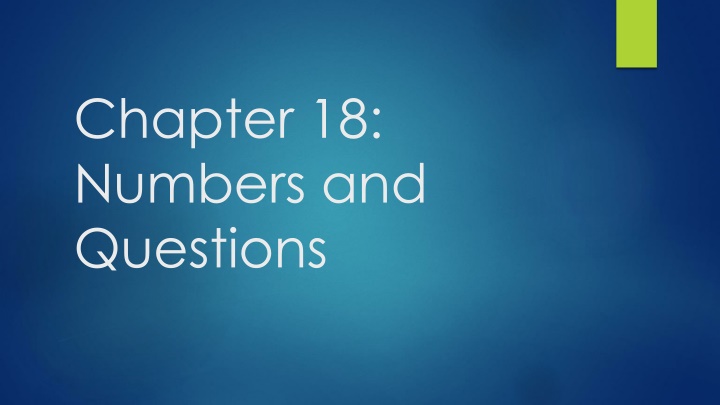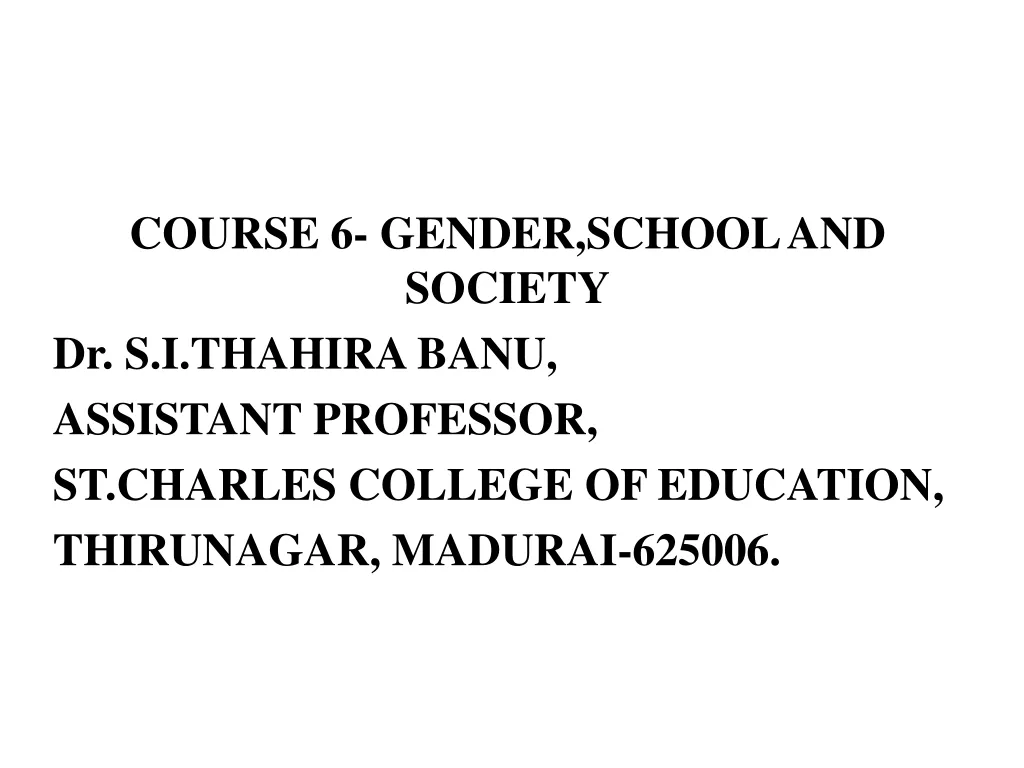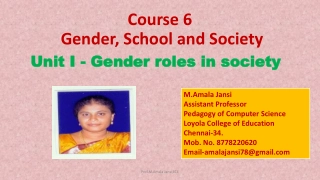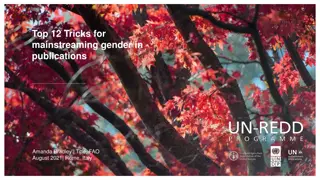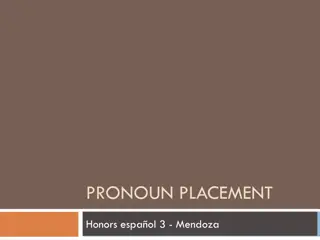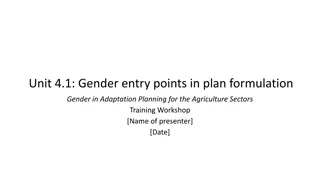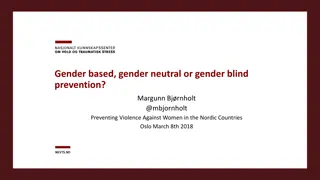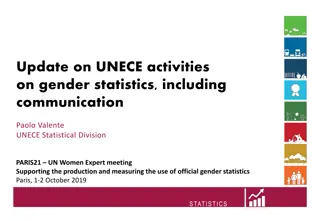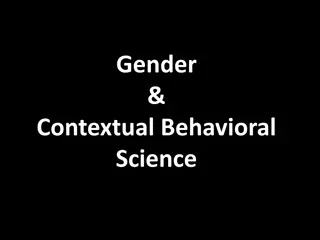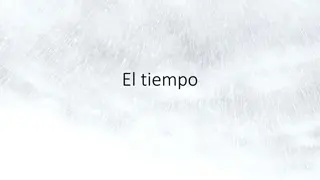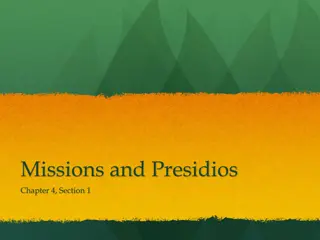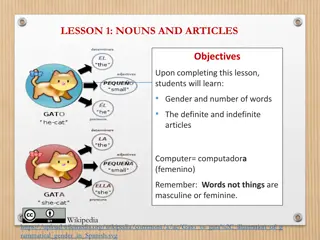Spanish Language Gender Rules and Examples
The rules of gender in the Spanish language based on word endings like -tion, -dad, and -ma, and providing examples of feminine and masculine nouns. Understand how Spanish nouns ending in -ión and -dad are always feminine, while words of Greek origin ending in -ma are generally masculine, with exceptions. Dive into the world of Spanish language gender norms and exceptions through this comprehensive guide.
Download Presentation

Please find below an Image/Link to download the presentation.
The content on the website is provided AS IS for your information and personal use only. It may not be sold, licensed, or shared on other websites without obtaining consent from the author.If you encounter any issues during the download, it is possible that the publisher has removed the file from their server.
You are allowed to download the files provided on this website for personal or commercial use, subject to the condition that they are used lawfully. All files are the property of their respective owners.
The content on the website is provided AS IS for your information and personal use only. It may not be sold, licensed, or shared on other websites without obtaining consent from the author.
E N D
Presentation Transcript
Chapter 18: Numbers and Questions
5.I. Oseh Shalom He who makes peace in his high places may he let peace descent on us and on all Israel and say, say: Amen.
5.I. Oseh Shalom May he make peace, may he make peace Peace for us and for all Israel
Qal Perfect Chant 1 CP we guarded 1CS I guarded 2 MP you (m.) guarded 2 MS you (m.) guarded 2 FS 2 FP you (f.) guarded you (f.) guarded 3 MS 3 CP they guarded he guarded 3 FS she guarded
Chant Personal Pronouns 1stcommon I we 2ndmasc. you (m.) you /ye / you all (m.) 2ndfem. you (f.) you / ye / you all (f.) 3rdmasc. he / it they (m.) 3rdfem. she / it they (f.)
Chant: Preposition with Pronominal Suffixes 1 CS in me 1 CP in us 2 MS in you (m.) 2 MP in you (m.) 2 FS in you (f.) 2 FP in you (f.) 3 MS in him 3 MP in them (m.) 3 FS in her 3 FP in them (f.)
Qal Imperfect Chant 1CS 1CP 2MP 3MP 2MS 2FS 2FP 3MS 3FS 3FP
11. D. Learn the following chant for : Imperative chant 2ms [you, m.s.] guard 2mp [you m.p.] guard 2fs [you, f.s.] guard [you f.p.] guard 2fp
12. A. Introduction to Infinitives Inf. Construct: (note it is the same as the 2ms Imperative) Inf. Absolute:
13. C. Participle chant: Qal Active Participle Singular Plural Masculine Feminine /
13. C. Participle chant: Qal Passive Participle Singular Plural Masculine Feminine
Niphal Chant: Perfect/Imperfect 1CS I was guarded Niphal Perfects 3CP they were guarded 2MS you (ms) Niphal Imperfect 3MP they (mp)
Niphal Imperatives, Infinitives, Ptc. Imprv / Inf Const. Fem. [=Inf. Const.] Inf. Abs. Ptc. Masc.
Piel Chants: Chant #15: 16. B. Strong Piel Perfect Verb Forms: Resultative. 1CS I guarded 3CP they guarded 16. D. Strong Piel Imperfect Verb Forms: Resultative. 2MS you (m) will guard 3MP they will guard
Piel Chants: Piel Imperative/ Piel Infinitive / Piel Participle: Impv = Piel Inf. Constr. Absolute Participles 2ms
Pual Chants: Chant #16: Pual Perfect 1CS I were kept 3CP Pual Imperfect: they (m) were kept 2MS 3MP you (m) will be kept they (m) will be kept
Pual Chants: Infinitive Constr. Inf. Abs Passive Participle: [ [
Chant #17: Hithpael Chants: Hithpael Perfect of (to be strong) 1CS I strengthened myself 3CP they strengthened themselves Hithpael Imperfect of (to be strong) 2MS you (m.) will strengthen yourself 3MP they will strengthen themselves
Chant #18: 17. C. Hiphil Perfect and Imperfect Chants Hiphil Perfect: 1CS 3CP Hiphil Imperfect: 2MS 3MP
Chant #18: 17. C. Hiphil Imperative, Infinitives and Participles Imprv / Inf Const. Inf. Abs. Ptc. Masc. Fem.
Hophal Perfect / Imperfect Chant Chant #19: Chant: Hophal Perfect (X was/were caused to keep) 1CS 3CP Hophal Imperfect (X will be caused to keep) 2MS 3MP
Hophal Imperative, Infinitive, Ptc. Imprv=Inf Const. Abs. caused to keep) Ptc. Masc. Fem.
18. A. Introduction to (numbers; =number sg.) In Hebrew they use their alphabet for words and for numbers. This is called gematria. Matthew 1 where it describes Christ s genealogy specifically crafted so that it is made up of three sets of exactly fourteen generations. After opening the book with Abraham and David the genealogies show that Jesus is the son of David (D=4, V=6, D=4 totaling to 14).
Letters as numbers 10 9 8 7 6 5 4 3 2 1 20 19 18 17 16 15 14 13 12 11 ... 22 21 =20, =30, =40, =50, =60, =70, =80, =90, =100, =200, ...
Counting to ten The tradition forms are masculine and feminine numbers matching the objects that they are associated with. Masculine Absolute Construct Absolute Construct 1 2 3 4 5 Feminine
One to ten 6 7 8 9 10
Numbers chant for modern Hebrew: 1 6 12 40 2 7 3 8 100 4 1000 9 5 10
Ten and over Basically the numbers 11-19 are just a combination of 1 + 10 etc. Note 12 which occurs frequently: (masc.) (fem.) The numbers 20, 30, 40 etc. are formed by making their corresponding number plural. Thus the frequently used number 40 is, as expected: 1,000 is 100 is
Ordinal Numbers The ordinal numbers are used to describe the days of the week (vid. Gen. 1). These are easily identified if you know how to count to ten as in our counting chant. Masculine Feminine First Second Third Fourth Fifth
Ordinal Numbers Sixth Seventh Eighth Ninth Tenth
with a guttural initial (that doesnt begin with a qame or a qame - atuf. with guttural initial words that have a qame or a qame - atuf, and
Interrogatives There are a series of interrogative adverbs that are often used to ask questions. We have seen some of these already. Why? , Who? What? Where? , , How? When?
Interrogatives The simplest way to ask a question is with an interrogative . This should not be confused with the definite article as it is usually attached differently to the beginning of a sentence in one of the following four ways: the normal way of attaching to non-guttural initial words that have a full vowel is how it looks when attached to a word whose first consonant begins with a ev
CHANT: The Why chant CHANT: The Why chant we learn for the six interrogatives is: ? who , what, where, how, why
18. F. Vocabulary List for Numbers 1. flock (sheep/goats) 2. in order that, so that 3. stone 4. flesh 5. desert, wilderness
18. F. Vocabulary List for Numbers 6. wicked 7. life 8. to fill, be full 9. loving kindness 10. foot, leg
